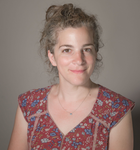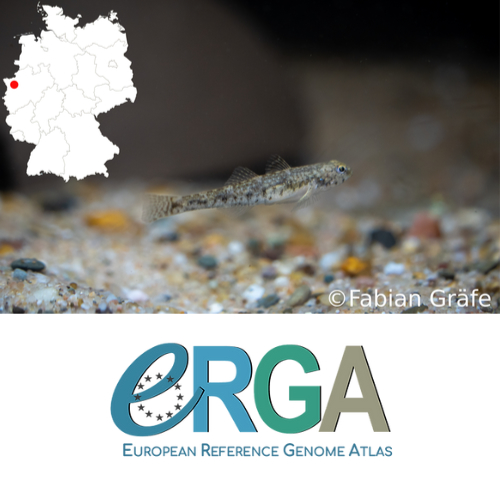
MANOUSAKI Tereza
- Institute of Marine Biology, Biotechnology and Aquaculture, Hellenic Centre for Marine Research, Heraklion, Greece
- Bioinformatics, Evolutionary genomics, Vertebrates
Recommendations: 0
Reviews: 2
Reviews: 2

Chromosome level genome reference of the Caucasian dwarf goby Knipowitschia cf. caucasica, a new alien Gobiidae invading the River Rhine
New chromosome-scale genome assembly for the Dwarf Goby, a River Rhine invader
Recommended by Iker Irisarri based on reviews by Tereza Manousaki, Ruiqi Li and 1 anonymous reviewerSince the opening of the Rhine-Main-Danube-Channel, four goby species are known to have invaded the River Rhine. Of these, the most recent and numerous is the Caucasian Dwarf Goby, which has been found in the Rhine since 2019. This study presents a new high-quality genome for this species (Knipowitschia cf. caucasica) (Schoenle et al. 2024). Currently, chromosome-scale genome assemblies represent a key first step in invasion biology, allowing the reconstruction of a species’ invasion history and monitoring its progress, as well as identifying and characterizing candidate genes that control invasiveness (McCartney et al. 2019).
The authors sequenced the nuclear and mitochondrial genomes of this species using state-of-the art methods including long-read sequencing techniques, scaffolded based on chromatin conformation data, and annotated using both direct transcriptomic and protein homology evidence. Data analyses follow currently established pipelines for genome assembly, scaffolding, annotation, and downstream bioinformatic analyses. The quality of the final genome was thoroughly assessed and conforms to what is expected from other genomes of fishes in the family Gobiidae. This study follows other recent endeavors that generated high-quality genomes to improve our understanding of invasion biology (e.g. Shao et al. 2020 and Kitsoulis et al. 2023). These studies are successfully contributing to increasing the genomic resources for the world’s most damaging invasive species, which were not available for even a third of the top 100 invasive species just five years ago (McCarthy et al. 2019). Beyond invasion biology, the Dwarf Goby genome is also an important resource for many other applications, including evolutionary genomic analyses and phylogeography of this species and closely related ones in their native ranges.
References
Kitsoulis CV, Papadogiannis V, Kristoffersen JB, Kaitetzidou E, Sterioti A, Tsigenopoulos CS, Manousaki T (2023) Near-chromosome level genome assembly of devil firefish, Pterois miles. Peer Community Journal 3:e64. https://doi.org/10.24072/pcjournal.295
McCartney MA, Mallez S, Gohl DM (2019) Genome projects in invasion biology. Conservation Genetics 20:1201–1222. https://doi.org/10.1007/s10592-019-01224-x
Schoenle A, Guiglielmoni N, Mainz T, Greve C, Hamadou AB, Heermann L, Borcherding J, Waldvogel A-M (2024) Chromosome level genome reference of the Caucasian dwarf goby Knipowitschia cf. caucasica, a new alien Gobiidae invading the River Rhine. bioRxiv, ver. 3 peer-reviewed and recommended by PCI Genomics. https://doi.org/10.1101/2024.04.22.590508
Shao F, Ludwig A, Mao Y, Liu N, Peng Z (2020). Chromosome-level genome assembly of the female western mosquitofish (Gambusia affinis). GigaScience 9:giaa092. https://doi.org/10.1093/gigascience/giaa092

The need of decoding life for taking care of biodiversity and the sustainable use of nature in the Anthropocene - a Faroese perspective
Why sequence everything? A raison d’être for the Genome Atlas of Faroese Ecology
Recommended by Stephen Richards based on reviews by Tereza Manousaki and 1 anonymous reviewerWhen discussing the Earth BioGenome Project with scientists and potential funding agencies, one common question is: why sequence everything? Whether sequencing a subset would be more optimal is not an unreasonable question given what we know about the mathematics of importance and Pareto’s 80:20 principle, that 80% of the benefits can come from 20% of the effort. However, one must remember that this principle is an observation made in hindsight and selecting the most effective 20% of experiments is difficult. As an example, few saw great applied value in comparative genomic analysis of the archaea Haloferax mediterranei, but this enabled the discovery of CRISPR/Cas9 technology (1). When discussing whether or not to sequence all life on our planet, smaller countries such as the Faroe Islands are seldom mentioned.
Mikalsen and co-authors (2) provide strong arguments to appreciate, investigate and steward genetic diversity, from a Faroese viewpoint, a fishery viewpoint, and a global viewpoint. As readers, we learn to cherish the Faroe Islands, the Faroese, and perhaps by extension all of nature and the people of the world. The manuscript describes the proposed Faroese participation in the European Reference Genome Atlas (ERGA) consortium through Gen@FarE – the Genome Atlas of Faroese Ecology. Gen@FarE aims to: i) generate high-quality reference genomes for all eukaryotes on the islands and in its waters; ii) establish population genetics of all species of commercial or ecological interest; and iii) establish a “databank” for all Faroese species with citizen science tools for participation.
In the background section of the manuscript, the authors argue that as caretakers of the earth (and responsible for the current rapid decrease in biodiversity), humanity must be aware of the biodiversity and existing genetic diversity, to protect these for future generations. Thus, it is necessary to have reference genomes for as many species as possible, enabling estimation of population sizes and gene flow between ecosystem locations. Without this the authors note that “…it is impossible to make relevant management plans for a species, an ecosystem or a geographical area…”. Gen@FarE is important. The Faroe nation has a sizable economic zone in the North Atlantic and large fisheries. In terms of biodiversity and conservation, the authors list some species endemic to other Faroe islands, especially sea birds. The article discusses ongoing marine environmental-DNA-based monitoring programs that started in 2018, and how new reference genome databases will help these efforts to track and preserve marine biodiversity. They point to the lack of use of population genomics information for Red List decisions on which species are endangered, and the need for these techniques to inform sustainable harvesting of fisheries, given collapses in critical food species such as Northwest Atlantic cod and herring. In one example, they highlight how the herring chromosome 12 inversion contains a “supergene” collection of tightly linked genes associated with ecological adaptation. Genetic tools may also help enable the identification and nurturing of feeding grounds for young individuals. Critically, the Faroe Islands have a significant role to play in protecting the millions of tons of seafood caught annually upon which humanity relies. As the authors note, population genomics based on high-quality reference sequences is “likely the best tool” to monitor and protect commercial fisheries. There is an important section discussing the role of interactions between visible and “invisible" species in the marine ecosystem on which we all depend. Examples of “invisible” species include a wide range of morphologically similar planktonic algae, and invasive species transported by ballast water or ship hulls. As biologists, I believe we forget that our population studies of life on the earth have so far been mostly in the dark. Gen@FarE is but one light that can be switched on.
The authors conclude by discussing Gen@FarE plans for citizen science and education, perhaps the most important part of this project if humanity is to learn to cherish and care for the earth. Where initiatives such as the Human Genome Project did not need the collaborative efforts of the world for sample access, the Earth BioGenome Project most certainly does. In the same way, at a smaller scale, Gen@FarE requires the support and determination of the Faroese.
References
1 Mojica, F. J., Díez-Villaseñor, C. S., García-Martínez, J. & Soria, E. Intervening sequences of regularly spaced prokaryotic repeats derive from foreign genetic elements. J Mol Evol 60, 174-182 (2005).
2 Mikalsen, S-O., Hjøllum, J. í., Salter, I., Djurhuus, A. & Kongsstovu, S. í. The need of decoding life for taking care of biodiversity and the sustainable use of nature in the Anthropocene – a Faroese perspective. EcoEvoRxiv (2024), ver. 3 peer-reviewed and recommended by Peer Community in Genomics. https://doi.org/10.32942/X21S4C